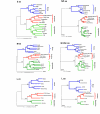Thottapalayam virus is genetically distant to the rodent-borne hantaviruses, consistent with its isolation from the Asian house shrew (Suncus murinus)
- PMID: 17711577
- PMCID: PMC1997112
- DOI: 10.1186/1743-422X-4-80
Thottapalayam virus is genetically distant to the rodent-borne hantaviruses, consistent with its isolation from the Asian house shrew (Suncus murinus)
Abstract
Thottapalayam (TPM) virus belongs to the genus Hantavirus, family Bunyaviridae. The genomes of hantaviruses consist of three negative-stranded RNA segments (S, M and L) encoding the virus nucleocapsid (N), glycoprotein (Gn, Gc), and polymerase (L) proteins, respectively. The genus Hantavirus contains predominantly rodent-borne viruses, with the prominent exception of TPM virus which was isolated in India in 1964 from an insectivore, Suncus murinus, commonly referred to as the Asian house shrew or brown musk shrew. Analysis of the available TPM virus S (1530 nt) RNA genome segment sequence and the newly derived M (3621 nt) and L (6581 nt) segment sequences demonstrate that the entire TPM virus genome is very unique. Remarkably high sequence differences are seen at the nucleotide (up to S - 47%, M - 49%, L - 38%) and protein (up to N - 54%, Gn/Gc - 57% and L - 39%) levels relative to the rodent-borne hantaviruses, consistent with TPM virus having a unique host association.
Figures

References
-
- Schmaljohn CS, Nichol ST. Bunyaviridae. In: Knipe DM, Howley PM, editor. Fields Virology. 5. Vol. 2. Philadelphia: Lippincott, Williams and Wilkins; 2007. p. 17411790.
-
- Plyusnin A, Morzunov SP. Virus evolution and genetic diversity of hantaviruses and their rodent hosts. Curr Top Microbiol Immunol. 2001;256:47–75. - PubMed
-
- Carey DE, Reuben R, Panicker KN, Shope RE, Myers RM. Thottapalayam virus: A presumptive arbovirus isolated from a shrew in India. Indian J Med Res. 1971;59:1758–1760. - PubMed
MeSH terms
LinkOut - more resources
Full Text Sources
Molecular Biology Databases
Research Materials
Miscellaneous

